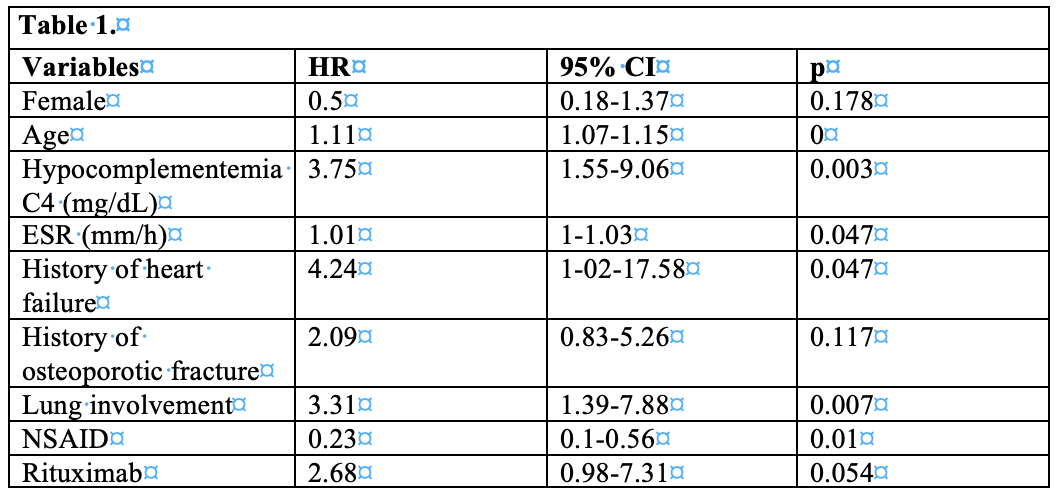Session Information
Session Type: Poster Session C
Session Time: 10:30AM-12:30PM
Background/Purpose: It remains debated if patients with Sjögren´s disease (SjD) have a greater mortality risk. The objective of our study was to determine the magnitude of all-cause risk of mortality in patients with SjD compared with the general population, analyze the causes, and identify predictive factors of mortality in SjD.
Methods: We analyzed data from SjögrenSER-PROS observational multicenter prospective cohort after 9 years of follow up. All patients included in the study fulfilled the 2002 American European Consensus Group classification criteria and participated in the cross-sectional phase of the study (SJÖGRENSER TRANS). Sociodemographic, clinical, and serological variables, comorbidities and treatments, as well as indicators of disease activity and organ damage were recorded. Continuous and categorical variables were analyzed using means, medians, and frequencies, with their respective deviations. Variables associated with mortality in univariate analysis were included in multivariate models to determine which ones were independently associated with the outcome of the disease. A linked registry study using information from our own registry combined with the Spanish Cause-of-Death Registry was performed and standardized mortality ratios (SMR) were calculated. Survival analysis was performed using Cox regression models to estimate which variables were associated with a greater mortality risk.
Results: A total of 314 patients were included (94.6% women) with an average age of 66 (± 11.45) and an average duration of the disease of 17 (±6,5) years. Over average of 9.6 [9.3-9.9] years of follow up 42 (13,4%) patients died. SMR was 1.7 CI 1.2-2.3. Infections (35,71%), cancer (23,8%), and cardiovascular disease (7,14%) de were the three leading causes of death. Higher disease activity, longer disease duration, lung involvement, hypertension, history of heart failure, peripheral arterial disease, osteoporosis, and osteoporotic fractures, the presence of antiphospholipid antibodies, hypocomplementemia C4, increased acute-phase reactants, the use of rituximab and bolus of corticosteroids (CS) were significantly associated with reduced survival in univariate analysis. See multivariable analysis of factor associated with mortality in table 1.
Conclusion: The existing data indicates 70% increase in mortality among patients with SjD compared with the general population. Older age, history of heart failure, hypocomplementemia C4, increase of ESR and lung involvement were independent risk factors associated with increased mortality. More attention should be paid to those patients with poor prognostic factors.
To cite this abstract in AMA style:
Rusinovich O, Plaza Z, Fernández Castro M, Rosas-Gómez de Salazar J, Martinez Taboada V, Olive A, Menor Almagro R, Serrano Benavente B, Font Urgelles J, Garcia-Aparicio A, Manrique-Arija S, García-Vadillo J, Lopez Gonzalez R, Narvaez-García J, Rodriguez M, Galisteo C, Gonzalez Martin J, Vela-Casasempere P, Bohorquez C, ERAUSQUIN ARRUABARRENA M, PAREDES ROMERO M, Aurrecoechea E, Melchor Diaz S, Pego-Reigosa J, Heredia Martin S, Moriano C, Blazquez Canamero M, Estrada-Alarcón P, Judez e, María Belzunegui: J, Ramos C, de la Puerta M, Sánchez-Alonso F, Andreu J. Mortality and Its Predictor Variables in Patients with Sjögren Disease: Data from SjögrenSER-Pros Prospective Registry [abstract]. Arthritis Rheumatol. 2024; 76 (suppl 9). https://acrabstracts.org/abstract/mortality-and-its-predictor-variables-in-patients-with-sjogren-disease-data-from-sjogrenser-pros-prospective-registry/. Accessed .« Back to ACR Convergence 2024
ACR Meeting Abstracts - https://acrabstracts.org/abstract/mortality-and-its-predictor-variables-in-patients-with-sjogren-disease-data-from-sjogrenser-pros-prospective-registry/

